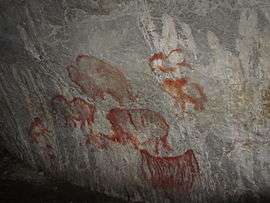Kapova Cave

Kapova cave (Russian: Капова пещера, also known as Shul'gan-Tash, Bashkir: Шүлгәнташ) is a limestone karst cave in Burzyansky District of Bashkortostan, Russia, ca. 200 km south-east of Ufa, in the southern Ural mountains. Located on the Belaya River in the natural reserve Shulgan-Tash, the cave is best known for the 16.000 years old Upper Paleolithic rock paintings and drawings.
The entrance to the cave is situated on the southern slope of the Sarykuskan (Russian: Сарыкускан) mountain. It represents a huge arch, 30 meters in height. To the left from the entrance to the cave, a lake is situated from which the river Shul'gan (Russian: Шульган) originates. Inside the cave, the Underground Shul'gan (Russian: Подземный Шульган) river flows, which created the cave. This three-storied cave system is about 3 km long, with a vertical amplitude of 165 m (including siphon underwater cavities), including large halls, galleries, underground lakes and the river.
Some 120 km from Kapova cave, the Ignatievka Cave is located.
|
References
Lawson, Andrew J. (2012). Painted Caves. Palaeolithic Rock Art in Western Europe. Oxford University Press. p. 197. ISBN 978-0-19-969822-6.
Silberman, Neil Asher, ed. (2012). The Oxford Companion to Archaeology. Oxford University Press. p. 176. ISBN 978-0-19-973578-5.
External links
- The real story of Russia Kapova Cave
- Official website of the Shulgan-Tash Natural Reserve
- Kapova Cave section of the official website of the Shulgan-Tash Natural Reserve
Coordinates: 53°02′40″N 57°03′50″E / 53.044444°N 57.063889°E

